|  
 
 
 
 
 
 
 | | | | 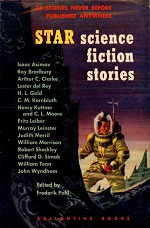

| | “A Scent of Sarsaparilla”
by Ray Bradbury
First publication: Star Science Fiction Stories, Feb 1953

Mr. William Finch is certain that the nostalgic feeling of cleaning out an attic is more than mere nostalgic, but his wife Cora is is more down-to-Earth. Consider an attic. Its very atmosphere is Time. It deals in other years, the cocoons and chrysalises of another age. All the bureau drawers are little coffins where a thousand yesterdays lie in state. Oh, the attic’s a dark, friendly place, full of Time, and if you stand in the very center of it, straight and tall, squinting your eyes, and thinking and thinking, and smelling the Past, and putting out your hands to feel of Long ago, why, it . . . Consider an attic. Its very atmosphere is Time. It deals in other years, the cocoons and chrysalises of another age. All the bureau drawers are little coffins where a thousand yesterdays lie in state. Oh, the attic’s a dark, friendly place, full of Time, and if you stand in the very center of it, straight and tall, squinting your eyes, and thinking and thinking, and smelling the Past, and putting out your hands to feel of Long ago, why, it . . . 
| |
| | | | |

 
 
 | | | | 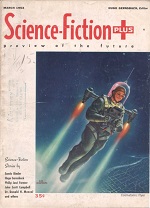

| | “The Time Capsule”
by Otto Binder (as by Eando Binder)
First publication: Science Fiction Plus, Mar 1953

I was surprised when I ran across the first issue of Science Fiction Plus (Mar 1953) and saw Hugo Gernsback, Editor, staring back at me from the top-right corner of the cover. Somehow I assumed that Wonder Stories was his last foray into what he called scientifiction, or even that he’d died when that magazine became Thrilling Wonder Stories in 1936. But, no, here he was again, albeit for only seven issues (Mar-Dec 1953) and with Sam Moskowitz behind the scenes.

That first issue had this Otto Binder story in which a farmer takes two archeologits, Stoddard and Jackson, to a time capsule that’s so unusual it couldn’t possibly have been buried by any known civilization. They take it to the Archeological Institute where their boss instructs them to clean up the outside apparently believing that they’ll stop once it’s clean. That thing has been buried for untold centuries perhaps. Millions of days. What would one more day matter? All right, go ahead, you two eager-beavers. But you’re getting the dirty work, scraping off that mold. That thing has been buried for untold centuries perhaps. Millions of days. What would one more day matter? All right, go ahead, you two eager-beavers. But you’re getting the dirty work, scraping off that mold. 
| |
| | | | |

 
 | | | | 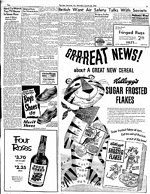 The Danville, VA, Bee, The Danville, VA, Bee,
26 Mar 1953, announcing the evening’s programs, including
“The Old Die Rich”

| | Tales of Tomorrow
hosted by Omentor (aka Raymond E. Johnson)
First time travel: 26 Mar 1953

The radio program spun off from the tv show of the day, but instead of having a deal for stories with the entire SFLA, it exclusively aired stories from Galaxy, including at least one time travel story, H.L. Gold’s “The Old Die Rich” on 26 Mar 1953. This is your host, Omentor, saying, “Hello.” I’d like to take a little trip to another century, just name your choice: You can go back through the years as far as you’d like or forward to the future and visit civilizations as yet unknown. Fantastic? Not if you use the proper vehicle, which in this case is a time machine. What’s that? Where do you find a time machine? Well, I found one in a remarkable story from Galaxy magazine. This is your host, Omentor, saying, “Hello.” I’d like to take a little trip to another century, just name your choice: You can go back through the years as far as you’d like or forward to the future and visit civilizations as yet unknown. Fantastic? Not if you use the proper vehicle, which in this case is a time machine. What’s that? Where do you find a time machine? Well, I found one in a remarkable story from Galaxy magazine. 
| |
| | | | |

 
 
 | | | | 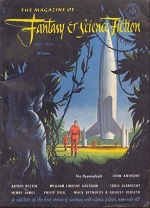

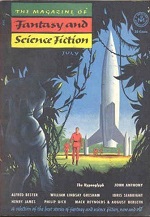

| | “The King’s Wishes”
by Robert Sheckley
First publication: The Magazine of Fantasy and Science Fiction, Jul 1953

 Bob and Janice, co-owners of the Country Department Store, are determined to catch the thief who’s sneaking in to steal appliances every night. Yes, they do capture him; yes, he’s from the past, in fact he’s a ferra (cousins of the jinni); no, I’m not going to tell you why he’s after all those generators, refrigerators, and air conditioners. Bob and Janice, co-owners of the Country Department Store, are determined to catch the thief who’s sneaking in to steal appliances every night. Yes, they do capture him; yes, he’s from the past, in fact he’s a ferra (cousins of the jinni); no, I’m not going to tell you why he’s after all those generators, refrigerators, and air conditioners.

By the way, I’d love to know more about the story behind the two different versions of the Emsh cover. The top one has the old F&SF logo, last used on the Sep 1952 issue; the bottom one has the new logo from Oct 1952 forward. Does anyone know the story behind this? The ferra of the cup has to be skilled in all branches of demonology. I had just graduated from college—with only passing grades. But of course, I thought I could handle anything. The ferra of the cup has to be skilled in all branches of demonology. I had just graduated from college—with only passing grades. But of course, I thought I could handle anything. 
| |
| | | | |

 
 | | | | 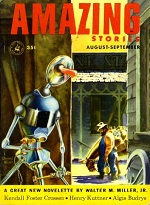

| | “Never Go Back”
by Charles V. de Vet
First publication: Amazing, Aug/Sep 1953

As his first experiment in time travel, Arthur Meissner visits his own childhood in 1933 with the hope of saving a friend who drowned in the local swimming hole. He seems to aver the friend’s disaster, but he himself no longer exists in 1933, and moreover, he no longer seems to exist even when he returns to his adult time.

By the way, this is another example of a time traveler who arrives naked. I wonder who first penned that now clichéd mode of arrival. Also, the story expresses an early version of the Chronology Protection Principle. You see, you yourself are the object in this particular instance, and by going back into time you—the same object—would be occupying two separate units of space at the same time, which is axiomatically impossible. Therefore, nature made its adjustment; the same as it would if an irresible force hit a so-called immovable object. It eliminates one of them. You see, you yourself are the object in this particular instance, and by going back into time you—the same object—would be occupying two separate units of space at the same time, which is axiomatically impossible. Therefore, nature made its adjustment; the same as it would if an irresible force hit a so-called immovable object. It eliminates one of them. 
| |
| | | | |

 
 
 
 
No Time Travel. Move along. |
The Time Masters by Wilson Tucker [long life ]

The Twonky by Henry Kuttner and C.L. Moore, 10 jun 1953 [no definite time travel ]

“Paycheck” by Philip K. Dick, Imagination, Jun 1953 [visions of possible futures ]

| |     |